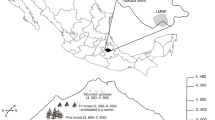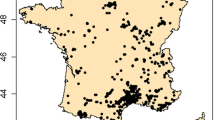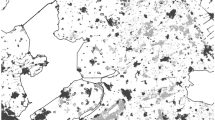Abstract
The development and use of acoustic recording technology, surveys have revealed the composition, relative levels of activity, and preliminary habitat use of bat communities of various forest locations. However, detailed examinations of acoustic surveys results to investigate temporal patterns of bat activity are rare. Initial active acoustic surveys of bat activity on the Quabbin Reservoir watershed in central Massachusetts recorded high numbers of call sequences by five bat species. The results showed the importance of aquatic and open habitats for bats in this diverse forest landscape. Because the preliminary surveys were restricted in extent (habitats), number (replicates), and duration (active surveys only, limited number of repeated surveys), the authors strongly recommended more comprehensive and extensive surveys of bat activity on the area. This paper reports the results of active (manual) and passive (automated) acoustic bat activity surveys in three replicates of ten habitats, conducted three to four times per year over the course of the study between 2004 and 2006. Over the full study, 2,800 actively-recorded 37,632 passively-recorded call sequences were examined and identified to species when possible. General patterns in activity did not differ by habitat between the two survey methods. Call sequences were recorded more often in open, especially aquatic habitats than in cluttered habitats. The use of passive surveys allowed for the assessment of temporal patterns of activity and an analysis of the relationship between ambient temperature and activity.



Similar content being viewed by others
References
Agosta SJ, Morton D, Marsh BD, Kuhn KM (2005) Nightly, seasonal, and yearly patterns of bat activity at night roosts in the central appalachians. J Mammal 86:1210–1219. doi:10.1644/05-MAMM-A-012R1.1
Aldridge HDJN, Rautenbach IL (1987) Morphology, echolocation and resource partitioning in insectivorous bats. J Anim Ecol 56:763–778. doi:10.2307/4947
Amelon S, Burhans D (2006) Conservation assessment: Myotis leibii (eastern small-footed myotis) in the eastern United States. In: Thompson FR (ed) Conservation assessments for five forest bat species in the eastern United States. US For Serv, North Central Res Sta, Gen Tech Rep NC-260. St Paul, MN
Anthony ELP, Stack MH, Kunz TH (1981) Night roosting and the nocturnal time budget of little brown bat, Myotis lucifugus: effects of reproductive status, prey density, and environmental conditions. Oecologia 51:151–156. doi:10.1007/BF00540593
Arbuthnott D, Brigham RM (2007) The influence of a local temperature inversion on the foraging behaviour of big brown bats, Eptesicus fuscus. Acta Chiropterol 9:193–201. doi:10.3161/1733-5329(2007)9[193:TIOALT]2.0.CO;2
Audet D, Fenton MB (1988) Heterothermy and the use of torpor by the bat Eptesicus fuscus (Chiroptera: Verpertilioinidae): a field study. Physiol Zool 61:197–204
Best TL, Jennings JB (1997) Myotis leibii. Mammalian Species No. 547. The American Society of Mammalogists. http://www.science.smith.edu/departments/Biology/VHAYSSEN/msi/default.html. Cited 21 Dec 2007
Brigham RM, Grindal SD, Firman MC, Morrisette JL (1997) The influence of structural clutter on activity patterns of insectivorous bats. Can J Zool 75:131–136. doi:10.1139/z97-017
Broders HG, Quinn GM, Forbes GJ (2003) Species status, and the spatial and temporal patterns of activity of bats in southwest Nova Scotia, Canada. Northeast Nat 10:383–398
Broders HG, Findlay CS, Zheng L (2004) Effects of clutter on echolocation call structure of Myotis septentrionalis and M. lucifugus. J Mammal 85:273–281. doi:10.1644/BWG-102
Broders HG, Forbes GJ, Woodley S, Thompson ID (2006) Range extent and stand selection for roosting and foraging in forest-dwelling northern long-eared bats and little brown bats in the Greater Fundy ecosystem New Brunswick. J Wildl Manage 70:1174–1184. doi:10.2193/0022-541X(2006)70[1174:REASSF]2.0.CO;2
Brooks RT, Ford WM (2005) Bat activity in a forest landscape of central Massachusetts. Northeast Nat 12:447–462. doi:10.1656/1092-6194(2005)012[0447:BAIAFL]2.0.CO;2
Brooks RT, Ford WM (2006) Introduction to the special section—bat habitat use in eastern North American temperate forests: site, stand, and landscape effects. J Wildl Manage 70:1171–1173. doi:10.2193/0022-541X(2006)70[1171:ITTSSH]2.0.CO;2
Caceres MC, Barclay RMR (2000) Myotis septentrionalis. Mammalian Species. The American Society of Mammalogists. http://www.science.smith.edu/departments/Biology/VHAYSSEN/msi/default.html. Cited 21 Dec 2007
Carter TC, Menzel MA, Owen SF, Edwards JW, Menzel JM, Ford WM (2003) Food habits of bats in the Allegheny plateau and ridge and valley of West Virginia. Northeast Nat 10:83–88
Ciechanowski M, Nając T, Biłas A, Bunajski R (2007) Spatiotemporal variation in activity of bat species differing in hunting tactics: effects of weather, moonlight, food abundance, and structural clutter. Can J Zool 85:1249–1263. doi:10.1139/Z07-090
Cryan PM (2003) Seasonal distribution of migratory tree bats (Lasiurus and Lasionycteris) in North America. J Mammal 84:579–593. doi:10.1644/1545-1542(2003)084<0579:SDOMTB>2.0.CO;2
Davis WH, Hitchcock HB (1965) Biology and migration of the bat, Myotis lucifugus, in New England. J Mammal 46:296–313. doi:10.2307/1377850
Downs NC, Racey PA (2006) The use by bats of habitat features in mixed farmland in Scotland. Acta Chiropterol 8:169–185. doi:10.3161/1733-5329(2006)8[169:TUBBOH]2.0.CO;2
Fenton MB (1990) The foraging behaviour and ecology of animal-eating bats. Can J Zool 68:411–422. doi:10.1139/z90-061
Fenton MB, Barclay RMR (1980) Myotis lucifugus. Mammalian Species No. 142. The American Society of Mammalogists. http://www.science.smith.edu/departments/Biology/VHAYSSEN/msi/default.html. Cited 21 Dec 2007
Ford WM, Menzel MA, Rodrigue JL, Menzel JM, Johnson JB (2005) Relating bat species presence to simple habitat measures in a central Appalachian forest. Biol Conserv 126:528–539. doi:10.1016/j.biocon.2005.07.003
Ford WM, Menzel JM, Menzel MA, Edwards JW, Kilgo JC (2006) Presence and absence of bats across habitat scales in the upper coastal plain of South Carolina. J Wildl Manage 70:1200–1209. doi:10.2193/0022-541X(2006)70[1200:PAAOBA]2.0.CO;2
Francl KE (2008) Summer bat activity at woodland seasonal pools in the northern Great Lakes region. Wetlands 28:117–124. doi:10.1672/07-104.1
Gannon WL, Sherwin RE, Haymond S (2003) On the importance of articulating assumptions when conducting acoustic studies of habitat use by bats. Wildl Soc Bull 31:45–61
Grindal SD, Brigham RM (1998) Short-term effects of small-scale habitat disturbance on activity by insectivorous bats. J Wildl Manage 62:996–1003. doi:10.2307/3802552
Hayes JP (1997) Temporal variation in activity of bats and the design of echolocation-monitoring studies. J Mammal 78:514–524. doi:10.2307/1382902
Hayes JP (2000) Assumptions and practical considerations in the design and interpretation of echolocation-monitoring studies. Acta Chiropterol 2:225–236
Johnson JB, Menzel MA, Edwards JW, Ford WM (2002) A comparison of 2 acoustical bat survey techniques. Wildl Soc Bull 30:931–936
Krusic RA, Yamasaki M, Neefus CD, Pekins PJ (1996) Bat habitat use in White Mountain National Forest. J Wildl Manage 60:625–631. doi:10.2307/3802081
Kuenzi AJ, Morrison ML (2003) Temporal patterns of bat activity in southern Arizona. J Wildl Manage 67:52–64. doi:10.2307/3803061
Kunz TH (1973) Resource utilization: temporal and spatial components of bat activity in central Iowa. J Mammal 54:14–32. doi:10.2307/1378869
Kunz TH (1988) Methods of assessing the availability of prey to insectivorous bats. In: Kunz TH (ed) Ecological and behavioral methods for the study of bats. Smithsonian Institution Press, Washington, DC
Kurta A, Baker RH (1990) Eptesicus fuscus. Mammalian Species No. 356. The American Society of Mammalogists. http://www.science.smith.edu/departments/Biology/VHAYSSEN/msi/default.html. Cited 21 Dec 2007
Massachusetts Department of Conservation and Recreation (MA DCR) (2007) Quabbin Reservoir watershed system: land management plant 2007–2017. Division of water supply protection, office of watershed management, Boston. http://www.mass.gov/dcr/watersupply/watershed/quablmp.htm. Cited 15 Jan 2008
Menzel JM, Menzel MA, McCracken GF, Chapman BR (2000) Notes on bat activity above the forest canopy in the eastern United States. Ga J Sci 58:212–216
Menzel JM, Menzel MA, Kilgo JC, Ford WM, Edwards JW (2005a) Bat response to Carolina Bays and wetland restoration in the southeastern U.S. coastal plain. Wetlands 25:542–550. doi:10.1672/0277-5212(2005)025[0542:BRTCBA]2.0.CO;2
Menzel JM, Menzel MA, Kilgo JC, Ford WM, Edwards JW, McCracken GF (2005b) Effect of habitat and foraging height on bat activity in the coastal plain of south Carolina. J Wildl Manage 69:235–245. doi:10.2193/0022-541X(2005)069<0235:EOHAFH>2.0.CO;2
Milne DJ, Fisher A, Rainey I, Pavey CR (2005) Temporal patterns of bats in the top end of the northern territory, Australia. J Mammal 86:909–920. doi:10.1644/1545-1542(2005)86[909:TPOBIT]2.0.CO;2
Norberg UM, Rayner JMV (1987) Ecological morphology of flight in bats (Mammalia: Chiroptera): wing adaptations, flioght performance, foraging strategy and echolocation. Philos Trans R Soc Lond 316:335–477. doi:10.1098/rstb.1987.0030
O’Donnell CFJ (2000) Influence of season, habitat, temperature, and invertebrate availability on nocturnal activity of the New Zealand long-tailed bat (Chalinolobus tuberculatus). NZ J Zool 27:207–221
Owen SF, Menzel MA, Edwards JW, Ford WM, Menzel JM, Chapman BR, Wood PB, Miller KV (2004) Bat activity in harvested and intact forest stands in the Allegheny Mountains. North J Appl For 21:154–159
Parsons K, Crompton R, Graves R, Markham S, Matthews J, Oxford M, Shepherd P, Sowler (2007) Bat surveys–good practice guidelines. Bat Conserv Trust, London
Reeder WG, Cowles RB (1951) Aspects of thermoregulation in bats. J Mammal 32:389–403. doi:10.2307/1375787
Sherwin RE, Gannon WL, Haymond S (2000) The efficacy of acoustic techniques to infer differential use of habitat by bats. Acta Chiropterol 2:145–153
Sleep DJH, Brigham RM (2003) An experimental test of clutter tolerance in bats. J Mammal 84:216–224. doi:10.1644/1545-1542(2003)084<0216:AETOCT>2.0.CO;2
Veilleux JP (2007) A noteworthy hibernation record of Myotis leibii (eastern small-footed bat) in MA. Northeast Nat 14:501–502. doi:10.1656/1092-6194(2007)14[501:ANHROM]2.0.CO;2
Verboom B, Spoelstra K (1999) Effects of food abundance and wind on the use of tree lines by an insectivorous bat, Pipistrellus pipistrelles. Can J Zool 77:1393–1401. doi:10.1139/cjz-77-9-1393
Weller TJ, Zabel CJ (2002) Variation in bat detections due to detector orientation in a forest. Wildl Soc Bull 30:922–930
Whitaker JO Jr (2004) Prey selection in a temperate zone insectivorous bat community. J Mammal 85:460–469. doi:10.1644/1545-1542(2004)085<0460:PSIATZ>2.0.CO;2
Zimmerman GS, Glanz WE (2000) Habitat use by bats in eastern Maine. J Wildl Manage 64:1032–1040. doi:10.2307/3803214
Acknowledgments
T. Maier, J. Silver, L. Carpenter, D. Petersen, and S. Wallace helped with bat activity surveys. The manuscript was reviewed by K. Nislow and M. Ford.
Author information
Authors and Affiliations
Corresponding author
Rights and permissions
About this article
Cite this article
Brooks, R.T. Habitat-associated and temporal patterns of bat activity in a diverse forest landscape of southern New England, USA. Biodivers Conserv 18, 529–545 (2009). https://doi.org/10.1007/s10531-008-9518-x
Received:
Accepted:
Published:
Issue Date:
DOI: https://doi.org/10.1007/s10531-008-9518-x




